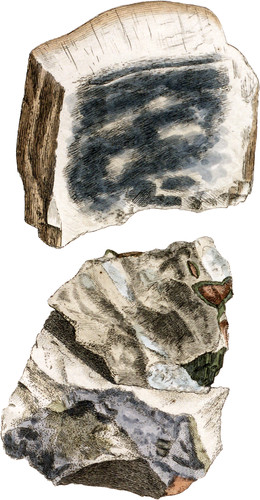 Enlarge
Enlarge
Exotic Mineralogy
Yttrocerite
- Syn.
- Yttrocerite. Gahn and Berzelius in Thompson’s Annals, ix. 72.
- Double Fluate of Cerium and Yttria. Ib. ix. 453.
For the discovery of the various minerals that contain Fluate of Cerium, we are indebted to the researches of Gahn, Berzelius, Wallman, and Eggertz: they have been found in the neighbourhood of Fahlun, both in the mines of Broddbo and Finbo. The most abundant is that known by the name of Yttroccrite, and which appears to be a mixture of the Fluate pf Cerium and the Fluate of Yttria, with Filiate of Lime; the purple colour common to which it often possesses. The following description of this is extracted from Thompson’s Annals:
“Its colour is various, violet, greyish red, white, grey, often all mixed in the same specimen. In amorphous masses, varying iu size from a thill crust to half a pound in weight, disseminated through quartz. Lustre glistening. Opake. Scratched by the knife and by quartz. Scratches Fluor spar. Spec. grav. 3.447.
“Before the blowpipe it loses its colour, and becomes white; but does not fuse of itself, but when mixed with Gypsum readily melts into a bead. When in line powder it dissolves completely in boiling muriatic acid, and the solution has a yellow colour; its constituents are—
| Lime | 47.63 to 50.00 |
| Yttria | 9.11 to 8.10 |
| Oxide of Cerium | 18.22 to 16.45 |
| Fluoric acid | 25.05 to 25.45 |
| 100.01 100.00 |
| Or Fluate of Lime | 65.162 to 68.18 |
| Fluate of Yttria | 11.612 to 10.60 |
| Fluate of Cerium | 23.226 to 20.22 |
| 100.000 99.00 |
A Filiate of Cerium, crystallized in six-sided prisms, containing of fluate of protoxide of Cerium 30.43, and of fluate of peroxide of Cerium 60.00 has been found, but specimens have not reached England. Another fluate, holding double the quantity of Cerium, amorphous, and strongly resembling porcelain Jasper, is also mentioned. A fourth mineral, more common than either of these, consisting of a variable proportion of the filiates of Cerium and Yttria, occurs in the quartz in small nodules or surrounding, or even mixed with Gadolinite; it is so soft that it may be easily scratched by the nail: its colours are deep red, pale red, white, nearly yellow, or reddish brown: this is the double filiate of Cerium and Yttria above quoted; it is found at Finbo.
Besides the substances already mentioned in these minerals, there was discovered by Berzelius, in the deuto fluate of Cerium, in amorphous masses from Finbo, which is analogous to the crystallized kind before mentioned, a new earth agreeing in some of its characters with Zirconia, but differing in several others, especially in not being preeipitated from its solutions by sulphate of Potash; this earth was also found in the double fluate of Cerium and Yttria, but its presence was not manifest in every specimen examined, and its existence could not be discovered by any effect it might have produced on the external characters. In the fifth volume of the Afhandlingar i Fysik, Kemi och Mineralogi, a full detail of these minerals, along with the other productions of the mines in the neighbourhood of Fahlun, is contained, together with an aecount of the properties of this new earth, which Berzelius proposes to name Thoria, from Thor, an ancient Scandinavian deity.
The upper figure represents a thin crust of the first mentioned fluate, called Yttrocerite, forming a film upon the surface of a fissure, in a mass of Pyrophysalite: this is from the British Museum.
The lowest figure is from an irregular mass of the same in white Feldspar, with Quartz and greenish Mica; lent me by John Dunston, Esq.
The other figure is from a rare specimen sent to the British Museum by Berzelius; it is the red kind, in some of which the Thoria has been discovered: it is a small reddish nodule, surrounded by green Mica, and imbedded in an aggregate of white Feldspar and Quartz.

